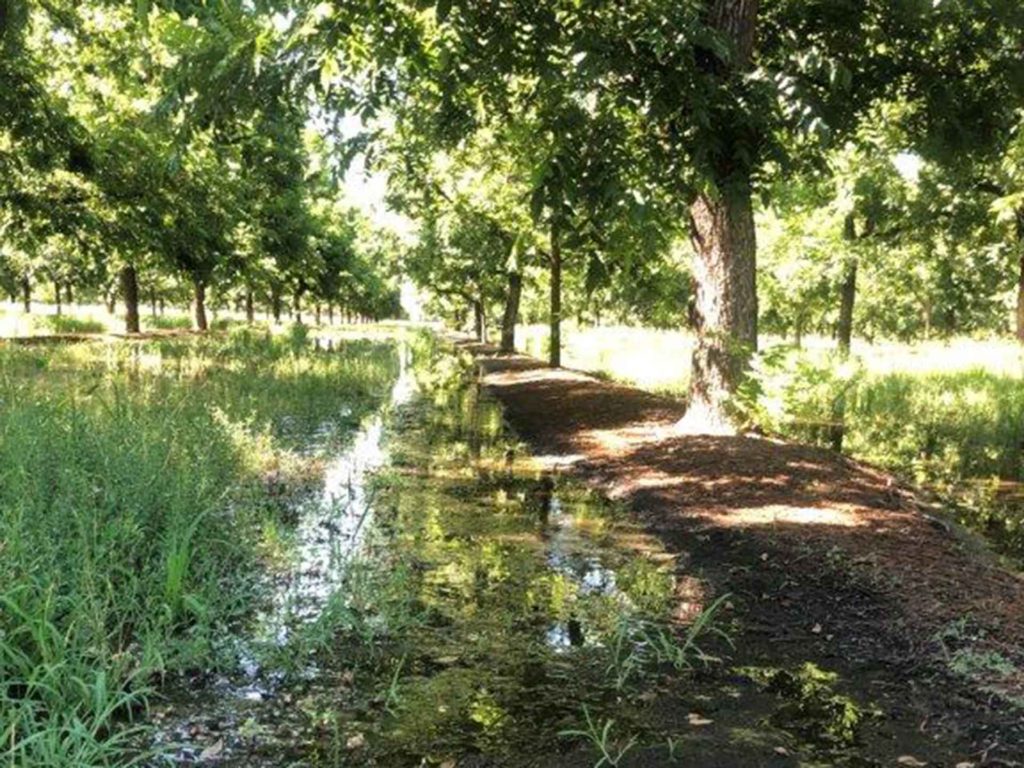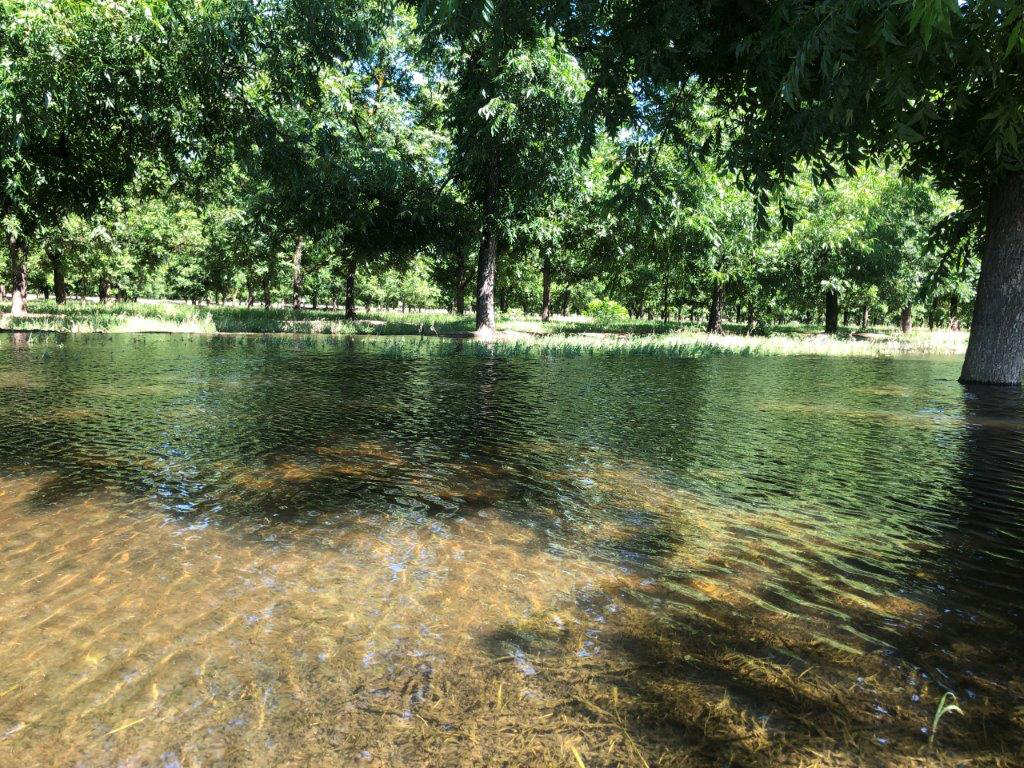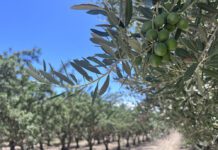For decades many California farmers had used flood irrigation as a means to irrigate their crops. As California was plagued by impacts of drought, farmers adopted more progressive methods of farming. Flood irrigation seemed to become a thing of the past. Over the past 30 years, there has been increased irrigation efficiencies within the nut industry and specifically with applying water directly to the root zones via micro irrigation.
Micro Irrigation
Micro irrigation was believed to be a better alternative to flood. Farmers would be able to minimize their water use while increasing the amount of water applied directly to the root zones. It seemed to be a win for all factors.
The lack of surface water deliveries had forced growers to become more dependent on groundwater. With the onset of the Sustainable Groundwater Management Act (SGMA), groundwater also became an often contested source of water. Aquifers were now becoming depleted from overdraft. Growers were not flood irrigating fields anymore and were more precise with their irrigation practices. But as they used less water to irrigate their crops, less water was being put back into the aquifers. While many believed flood irrigation was a wasteful way to irrigate, it did however provide for groundwater recharge at the same time.

Groundwater Banking
There is a long history of many water storage districts across the Central Valley of California using groundwater banking or storage ponds to store the snow melt and water runoff from the wet months. This allowed for farmers to utilize the water during the dry months more feasibly. Now it seems many growers are following suite and experimenting with ways to adopt on-farm recharge practices of their own. On-farm recharge is allowing farmers themselves to capture excess floodwater in the wet months and apply it to farmland post-dormancy to recharge aquifers. Being able to keep your farmland in production and not have to fallow while recharging the aquifer really is the best scenario for farmers.
The University of California Cooperative Extension (UCCE) office, University of California (UC) Davis, Sustainable Conversation, Bachand & Associates, California Pecan Growers Association and Pacific Gold Agriculture are all partnering on the study “On-Farm Recharge on Pecans for Groundwater Sustainability”. Pacific Gold Agriculture’s pecan orchard located in McFarland California serves as the sight for the study. According to the release “pecans have not been studied however, they may be especially suited for the on-farm recharge because they are facultative upland species able to tolerate saturated soils and post dormancy flooding”. The parties involved are hoping to prevent negative agronomic impacts while utilizing increased water supplies when available.
The Study
Bachand & Associates outlined four purposes in the study. “They hope to develop innovations in groundwater recharge and drought resilience. Develop strategies, tools, and recommendations to enable stakeholders to adapt to climate change by recharging groundwater and sequestering carbon. Characterize the vadose zone in pecans orchards to track constituent mobilization while flushing soil. And finally, to develop cost analysis for implementing on-farm recharge practices in pecans.”
The initial study included four different treatments in four different pecan blocks. The continuous flooding of a five-acre block of pecans for 45 days, a ten-acre block utilizing periodic flooding for a ten day on and ten day off schedule, a ten-acre block with irrigation of 200 percent their normal practices and a twenty-four-acre control block with standard irrigation as the control field. The four treatments were monitored over the course of the 45 days by the cooperative extension and UC Davis parties involved.
Soil probes were strategically placed throughout the fields and within the four test blocks for monitoring. The probes were being used to measure water content, temperature and oxygen at the various locations. There were also surface sensors that collected water levels, the electrical conductivity and temperature of the flooded water. It was important to test the surface water and monitor the penetration levels of the water to test the correlation between the two. Each block was monitored independently and regularly.

Initial Differences
Mike Powell, with Pacific Gold Agriculture, noted no real initial differences in the condition of the trees immediately following the 45 days. The continuous flooded field was completely saturated in numerous areas throughout the field making it inaccessible due to the high levels of water. No cultural practices were completed on the continuous flooded field, including missed pesticide applications that would have normally occurred. There were no initial signs of increased pest pressures. There was an increase in natural animal habitat. Powell commented on the increase of tadpoles, frogs, and even raccoons making home in the flooded environment they created.
Powell noted “it is hard to see any initial impact of the continuous flooding; it will take time to see what benefits or any implications of the study are present. Pecan trees are pretty resilient and can handle flooding or stress pretty well. We won’t know until they set a crop and we harvest it, how the flooding impacted the yield if any.” Being a permanent crop, it could potentially not show impacts the first year, and may not show true signs of any consequences until further down the line of production or lifespan of the tree. Powell is optimistic and looking for this study to really serve as a starting point for many other growers to follow suite in doing their own on-farm recharge projects. He sees the real potential in recharge projects and continuing to farm while doing it. “With the onset of SGMA, fallowing of land is a reality, but if we can recharge and grow crops on the same land, maybe we won’t have to fallow as much. “Powell optimistically pointed out.

There are three goals of the project outlined by Bachand and Associates; “establish and implement field studies for on-farm recharge at the pecan test blocks, develop viable technology through on-farm recharge on pecan orchards to recharge groundwater while maintaining good tree health and yields while increasing pecan acreage distribution to help Groundwater Sustainability Agencie’s (GSA) achieve SGMA compliance, and lastly to distribute outreach and information about science based management tools to all growers.”
Research Continues
This study is ongoing and the data from the first phase is currently being analyzed. They plan to continue the experiment next winter by utilizing any excess water available from their water storage district. The study has a current completion date of April 2021. Powell and other farmers will be patiently waiting to see how they can further implement changes. Innovation is what is going to keep growers moving forward and looking for more ways to keep their farms sustainable and viable throughout the implementation of SGMA.
















